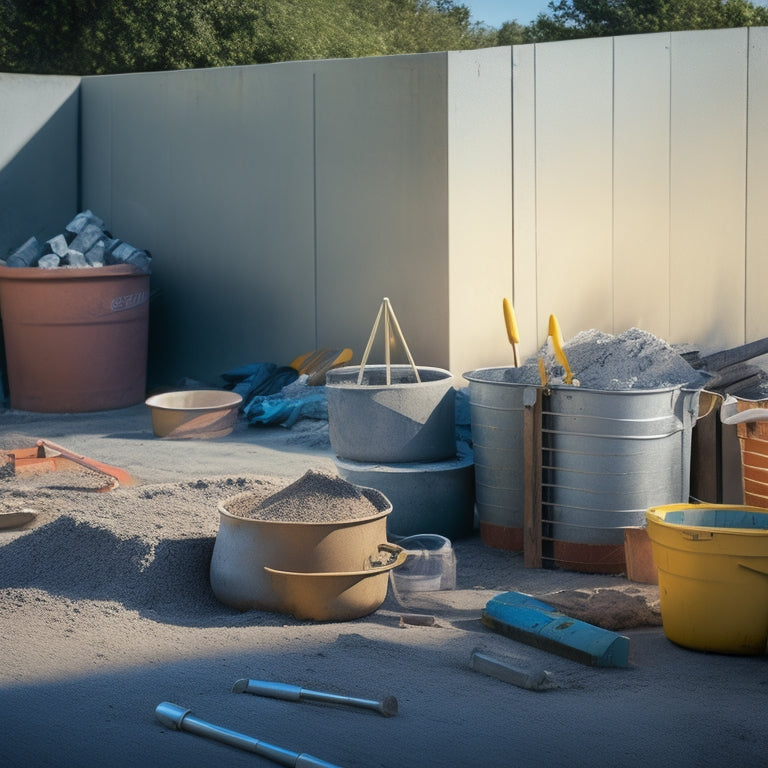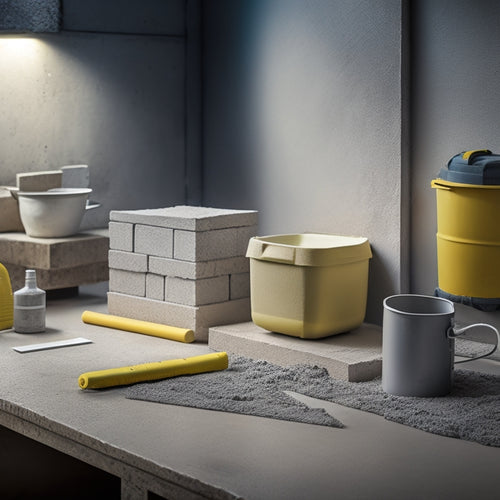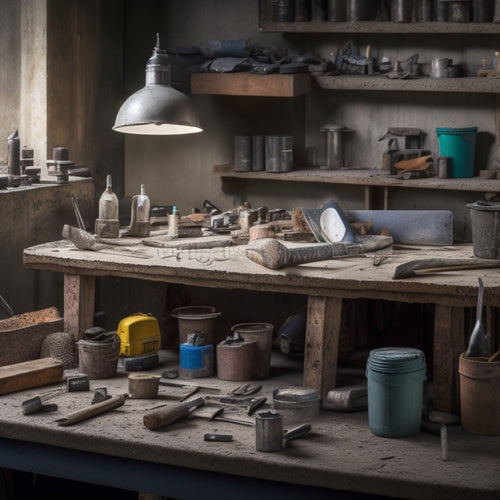
3 Best Tools for Concrete Fence Installation Success
Share
To achieve concrete fence installation success, you'll need a trio of essential tools: a measuring tape for accurate layout, a laser level for precise leveling and plumb checking, and a string line and stakes to maintain a straight course. These tools will guarantee your fence is properly aligned and measured. By incorporating these must-haves into your workflow, you'll set yourself up for success and be well on your way to a professional-grade installation; now, uncover the specifics on how to maximize their potential and discover more game-changing tools to elevate your project's results.
Key Takeaways
• A measuring tape is essential for accurate length and width measurements to ensure a precise fence layout.
• A laser level projects a precise level line to guarantee plumb and level installation.
• A mixing bucket and concrete mixer are necessary for preparing concrete for fence post installation.
• A finishing trowel and power trowel are vital for refining the surface and achieving a smooth finish.
• A site square ensures corners are square and fence alignment is correct, preventing costly mistakes.
Essential Layout and Measurement Tools
When installing a concrete fence, you must accurately layout and measure the site to guarantee a successful project. To do so, you'll need the following essential tools.
A high-quality measuring tape is a must-have for measuring the length and width of your fence line. Look for a tape that's durable, resistant to kinking, and has clear markings for easy reading.
A laser level is another important tool for making sure your fence is perfectly level and plumb. This device projects a precise level line, allowing you to check your work as you go.
Additionally, a string line and stakes will help you mark the fence line and maintain a straight course.
A calculator will come in handy for calculating the quantity of materials needed and verifying your measurements.
Finally, a site square will help you make certain your corners are square and your fence is properly aligned.
With these tools in your arsenal, you'll be well-equipped to tackle the layout and measurement phase of your concrete fence installation project.
Concrete Mixing and Pouring Tools
Accuracy and control are essential as you shift to the concrete mixing and pouring phase, where the quality of your tools can make all the difference in achieving a strong, durable fence.
With the right tools, you'll be able to master various mixing techniques and pouring methods to guarantee a flawless installation.
Here are the must-have tools for concrete mixing and pouring:
-
Mixing Bucket: A sturdy, heavy-duty bucket designed for mixing concrete, with a capacity of at least 5 gallons to accommodate large batches.
-
Concrete Mixer: A powerful, electric or gas-powered mixer that can handle heavy loads and mix large quantities of concrete efficiently.
-
Pouring Trough: A long, narrow trough used to pour concrete into tight spaces or long, narrow forms, guaranteeing a smooth, even flow.
- Vibrator: A handheld or electric vibrator that helps remove air pockets and settle the concrete, resulting in a stronger, more durable fence.
Finishing and Smoothening Tools
As you shift to the finishing stage, you'll need to equip yourself with specialized tools to refine the concrete's surface, eliminating imperfections and achieving a smooth, even finish.
In this stage, the right trowel types can make all the difference. You'll want to use a steel trowel for rough finishing, followed by a resin or epoxy trowel for finer finishing. For an ultra-smooth surface, consider using a power trowel with a helical blade.
When it comes to achieving specific surface finishes, you'll need the right tools for the job. For a broom finish, use a broom or a specialized broom finish tool to create the desired texture.
For a stamped finish, use stamping mats or texture mats to create the pattern. And for a high-gloss finish, use a series of progressively finer grit sandpapers, finishing with a high-gloss sealer.
Frequently Asked Questions
How Long Does It Take for Concrete to Fully Cure?
You're likely wondering how long it takes for concrete to fully cure. The curing process is vital, and it's important to understand the drying time.
Typically, concrete reaches its initial set within 24-48 hours, but it takes around 28 days to fully cure. However, this timeframe can vary depending on factors like temperature, humidity, and mix design.
You'll need to verify the concrete is properly cured to achieve ideal strength and durability.
What Safety Gear Is Required for Concrete Fence Installation?
When working at heights or in confined spaces during concrete fence installation, you'll need to prioritize safety.
You're required to wear safety harnesses to prevent falls and serious injuries. Additionally, protective eyewear is a must to shield your eyes from flying debris and chemical splashes.
Don't compromise on your safety – invest in high-quality gear that meets industry standards to guarantee a secure and successful installation process.
Can I Install a Concrete Fence on a Slope?
When you're installing a concrete fence on a slope, you'll need to take into account the unique challenges it presents.
First, assess the slope's angle and determine if it's stable enough to support the fence's weight.
Then, incorporate slope considerations into your design, such as stepped or tiered sections, to guarantee stability.
Don't forget to implement drainage solutions, like french drains or swales, to prevent water accumulation and erosion.
With careful planning, you can successfully install a concrete fence on a slope.
How Do I Prevent Cracks in a Concrete Fence?
When building a concrete fence, you'll want to prioritize crack prevention to guarantee its durability.
To do this, you'll need to incorporate concrete reinforcement, such as rebar or fiber mesh, into your design. This will help distribute stress and prevent cracks from forming.
Additionally, make sure to properly cure the concrete, using techniques like misting or applying a curing compound, to prevent shrinkage cracks.
Can I Paint or Stain a Concrete Fence After Installation?
You're wondering if you can paint or stain your concrete fence after installation. The answer is yes, but it's essential to choose the right paint types and stain application methods.
Acrylic or epoxy-based paints work well, while acid-based stains provide a natural, mottled look.
Make certain the fence is fully cured and clean before applying a primer and your chosen finish.
Follow the manufacturer's instructions for best results, and consider consulting a professional if you're unsure about the process.
Conclusion
You've made it to the final stage of your concrete fence installation project. With the right tools, you've guaranteed a strong, durable, and visually appealing fence.
Did you know that according to the American Concrete Institute, the global concrete market is projected to reach $547.3 billion by 2025? This growing demand highlights the importance of precision and quality in concrete construction.
By mastering the three essential tool categories, you'll be well-equipped to capitalize on this trend and deliver exceptional results.
Related Posts
-

What Tools Do I Need for Concrete Block Laying
You'll need a thorough set of tools to guarantee accurate, efficient, and professional concrete block laying. Essenti...
-

Top Tools for Concrete Repair Success
When it comes to concrete repair success, you'll need a well-stocked toolkit with essential hand tools like trowels, ...
-

Why These Concrete Tools Are Always in Demand
You rely on a set of trusted concrete tools to deliver high-quality results, and it's not surprising - these tools ar...


